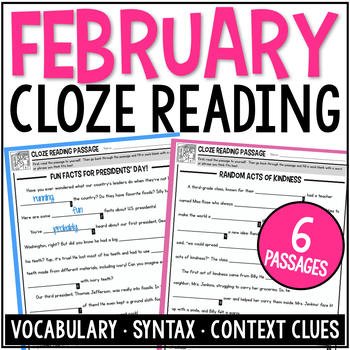February Cloze Reading Passages Valentine's Day, Presidents Vocabulary, Syntax
- PDF
Description
These FEBRUARY Cloze Reading Passages encourage students to use context clues and make inferences to determine the sentence's correct word or phrase. These passages are focused on President's Day, Groundhog Day, Rosa Parks, Games, Friendship, and Kindness.
See the titles below. Cloze reading exercises can help to improve reading accuracy and comprehension by focusing on vocabulary and syntax.
INCLUDED IN THIS FEBRUARY CLOZE READING RESOURCE
- SIX February Cloze reading passages
- Reflection sheet
- Lists of suggested words
- Directions on how to use Cloze reading passages in the classroom.
FEBRUARY TITLES INCLUDE
- Fun Facts for Presidents' Day (informational) - 2 pages
- Groundhog Day (informational) - 2 pages
- A Brave Woman Who Changed the World - Rosa Parks (informational) - 2 pages
- The Winter Games Adventure (fictional story) - 2 pages
- Friendship Bracelets (how to) - 2 pages
- Random Acts of Kindness (fictional story) - 2 pages
What is Cloze Reading?
Cloze reading takes the fill-in-the-blank strategy up a notch. It requires a deeper level of comprehension.
In Cloze reading passages, words are selectively removed from the reading passage. Multiple answers may fit the space, requiring students to rely on context clues and their understanding of syntax to determine the suitable options. While there is no one right answer that can fill the space, there are words that fit better than others.
Cloze reading is a great tool to help students draw inferences and promote critical thinking about word choice and syntax.
How Can Teachers Use Cloze Reading Passages in the Classroom?
One way to use a Cloze reading passage is to provide students with a paragraph or passage with blank spaces. Do not provide the words that you would include in the blanks.
- Have individual students read the passage.
- Then have them fill in the blanks independently.
- Have students share their responses with a partner or small group.
- Then have small groups share with the whole class.
- Discuss students’ word choice digging into vocabulary, synonyms, context clues, and more.
See this blog post about how Close Reading is different from fill-in-the-blank and sentence frames
CLICK HERE TO FOLLOW ME ON TPT | CLICK HERE TO CHOOSE A FREE RESOURCE
TERMS OF USE
Copyright © What I Have Learned, Jessica Boschen
Permission to copy for single classroom or homeschool family use only.
This product may not be distributed or displayed digitally for public view.
Please purchase additional licenses if you intend to share this product.





